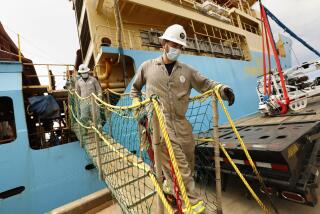Fishermen Say Ban on Bombs Will Do Dolphins More Harm Than Good
- Share via
Tuna industry representatives reacted angrily Wednesday to a new government ban on the use of explosives that have long been used to manipulate dolphins swimming near schools of the fish.
“My opinion is that this (ruling) does more harm than good,” said Bob Virissimo, chairman of the board of the American Tunaboat Assn., the San Diego-based trade group representing the owners of the 29 U. S. vessels that fish for tuna in the Eastern Pacific.
In outlawing the three-inch-long devices, U. S. regulatory authorities ruled that the bombs pose a threat to the dolphins--a view disputed by the industry.
Tuna fishermen say the ban, which goes into effect today, could result in even greater harm to the marine mammals because it takes away a means to help them escape from tuna nets.
However, conservationists dispute the fishermen’s position, saying the bombs injure dolphins and that the benefits of the explosives accrue more to the fishermen than to the dolphins. The new prohibition will save many dolphins, according to one prominent environmentalist, who acknowledged that the ban may make it more difficult for fishermen to catch tuna.
“We completely support a full ban” on the bombs, said David Phillips, director of the San Francisco-based Earth Island Institute. “They’d probably catch more tuna if they used depth charges, too, but that doesn’t mean it’s a good idea. . . . We think continuing use of these bombs would be unconscionable.”
August Felando, president of the American Tunaboat Assn., contends there is “no evidence whatsoever” that the devices, “as used by fishermen,” cause any injury to dolphins. That view was disputed by Phillips, who cited studies showing that the bombs have blown holes in dolphin carcasses used in tests.
The National Marine Fisheries Service, which enacted the ban, issued a statement saying that studies concluded that the explosives “could result in obvious physical damage to the animals as well as possible hearing impairment.”
Federal authorities say fishermen use the so-called seal bombs for three basic purposes: to herd schools of dolphins (and therefore the tuna) toward the huge nets, to keep dolphins in certain “safe” areas of the nets and to drive dolphins out of the nets after the tuna have been captured.
The bombs, tossed from boats and helicopters, have been in use for more than a decade, fishermen say.
In 1988, Congress mandated that the Commerce Department, parent body of the fisheries service, prohibit or restrict the use of seal bombs if research determined that the devices injured dolphins. That congressional action ultimately resulted in the new ban.
Foreign-registered tuna vessels, which make up the great majority of the world tuna-fishing fleet, have 180 days to comply with the prohibition. Foreign fishermen who continue to fish with the bombs face possible bans on import of tuna into the United States.
The fisheries service will take comment on the new ban for the next 30 days. Thereafter, the regulation will be modified or made final, although tuna industry representatives voiced little hope that they could effect major modifications.
For unknown reasons, yellowtail tuna tend to congregate beneath schools of dolphin in the Eastern Pacific between Southern California and Chile. That fact has long been known to fishermen, who set their vast purse-seine nets around the dolphins, capturing them together with the tuna. Many dolphins perish.
Each year, conservationists estimate that tuna fishermen worldwide kill 100,000 dolphins that become trapped in nets.
More to Read
Sign up for Essential California
The most important California stories and recommendations in your inbox every morning.
You may occasionally receive promotional content from the Los Angeles Times.













